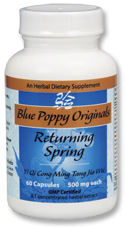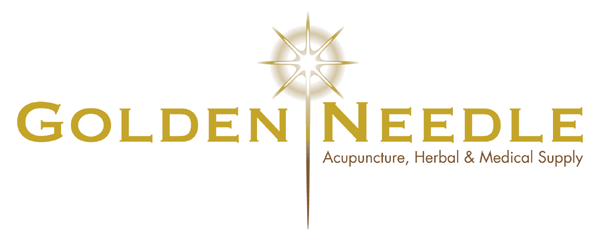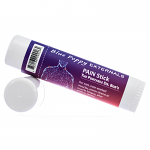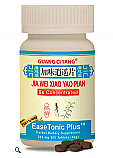$0.00 (0 items)
Returning Spring

Returning Spring
| SKU | BP131 | |
| Brand | Blue Poppy Originals | |
| Unit Size | 60 vegicapsules | |
| Dosage | Three capsules two times per day. | |
| Potency | 10:1 | |
| Properties | For the preventative or remedial treatment of qi and yin vacuity with vacuity heat, qi stagnation, and blood stasis, and phlegm turbidity causing or as a result of aging, with decreased auditory, visual, and mental function. | |
| Chinese Symptomology | The signs and symptoms of spleen qi vacuity include: * fatigue * loss of strength * shortness of breath * orthostatic hypotension * an enlarged tongue with teeth-marks on its edges The signs and symptoms of blood and yin vacuity with vacuity heat include: * grey hair * dry skin * presbyopia (decreased visual acuity, e.g., night-blindness, blurred vision) * decreased auditory acuity * low back and lower limb soreness and limpness * a red tongue with scanty fur and/or fluid * a surging or fine, bowstring, possibly rapid pulse The signs and symptoms of qi stagnation include: * irritability * a bowstring pulse The signs and symptoms of blood stasis include: * age spots * varicosities (including cherry hemangiomas) * "broken" beins (e.g., acne rosacea, spider nevi) * chronic pain * a purple tongue and/or possible static macules or speckles * distended, tortuous sublingual veins * a choppy pulse, bound, regularly intermittent, or skipping pulse The signs and symptoms of phlegm turbidity include: * phlegm nodulations (including round, nodular calcifications) * lipomas * pterygium * corneal opacity * a slippery pulse | |
| Pattern | Qi and yin dual vacuity with vacuity heat, qi stagnation and blood stasis, with phlegm turbidity | |
| Chinese name | YI QI CONG MING TANG (JIA WEI) | |
| English name | Returning Spring | |
| Description | To understand this formula, one must understand the aging process according to Chinese medicine. The signs and symptoms of aging generally have to do with qi and blood vacuity evolving into yin and yang vacuity complicated by blood stasis and phlegm turbidity. While most students and practitioners of Chinese medicine know that kidney vacuity is seen as the root of aging, many do not know that it is prior spleen vacuity which gives rise to kidney vacuity in the elderly. Further, when such a spleen vacuity leads to kidney vacuity, the spleen vacuity does not suddenly disappear, but continues. In this case, one now has a spleen-kidney dual vacuity or a qi and yin dual vacuity.
The spleen is the latter heaven root, the kidneys are the former heaven root, and former and latter heavens are mutually rooted. During young adulthood, the spleen is fortified (or healthy) and so engenders a surplus of qi and blood. This surplus is stored in the kidneys as latter heaven essence and bolsters and supports the former heaven essence which is intrinsic to the kidneys. However, in the mid-30s and early 40s, the spleen qi becomes vacuous and weak due to years of dietary indiscretions, too much work, too little rest, too little physical exercise, too much worry and thought, a host of unfulfilled desires, etc. This spleen vacuity then leads to a decrease in the production of qi and blood and, therefore, also in the production of latter heaven essence. By the later 40s and into the 50s, the organism must start dipping into its "capital," the former heaven essence. It is this which leads to the kidney vacuity so commonly identified with aging in Chinese medicine. In this case, there is not enough qi to power function -- for instance, the function of the eyes, ears, heart, and mind. Nor is there enough blood and yin to nourish and moisten the viscera, bowels, and body tissues. Further, because of qi vacuity, there is not the power to stir or push the blood and body fluids. Hence, there is a tendency towards the enegenderment of blood stasis and phlegm turbidity. These two species of evil qi, then further block and obstruct the free flow of qi and blood and the function of the viscera and bowels. Thus, a negative feedback loop is created between the existence of righteous vacuities and evil qi which leads inexorably to debility and eventual death. Based on this description of the aging process, it is said in Chinese medicine: " The kidneys govern growth, maturation, decline, and death." "In the elderly, blame the spleen." "In the elderly, there is lots of blood stasis." "In the elderly, there is lots of phlegm." "At 40 years [of age], yin is automatically half." Therefore, if one wishes to slow the aging process or reverse some of the common symptoms of aging, one needs to fortify the spleen and supplement the qi, nourish the blood and enrich yin, quicken the blood, and transform phlegm. Since of the most disturbing symptoms of aging are cognitive and sensory deficits (such as decreased memory, vision, and hearing), one also typically needs to boost the intelligence and open the orifices, and that is exactly what this formula seeks to do. Ni Wei-de created Yi Qi Cong Ming Tang approximately 120 years after the publication of Li Dont-yuan's Pi Wei Lun (Treatise on the Spleen & Stomach) its famous formulas Bu Zhong Yi Qi Tang (Supplement the Center & Boost the Qi Decoction). It is clear from the name of this formula (Yi Qi, Boost the Qi) that Ni was a proponent of Li-Zhu medicine (i.e. the medicine of Li Dont-yuan and Zhu Dan-si). Thus, he knew the pivotal importance of spleen and yin vacuities. Traditionally, Yi Qi Cong Ming Tang is used to treat long-term middle burner vacuity causing yin fire resulting in all sorts of chronic disturbances in vision and hearing, including loss of visual and auditory acuity, corneal opacity, pterygium, and tinnitus. Within this expanded version of Yi Qi Cong Ming Tang, Huang Qi, Tai Zi Shen, and mix-fried Gan Cao fortify the spleen and boost the qi. Bai Shao, Nu Zhen Zi, Gou Qi Zi, Dan Shen, Ge Gen, and Tai Zi Shen nourish the blood and supplement yin. Chuan Xiong, Yu Jin, and Dan Shen quicken the blood and transform stasis. Shi Chang Pu and Yuan Zhi transform phelgm. Chuan Xiong and Man Jing Zi promote the movement of qi and blood in the head. Man Jing Zi specifically clears and benefits the head and eyes. Gou Qi Zi is famous for brightening the eyes or improving vision. Shi Chang Pu opens the orifices (in particular, the ears), quiets the spirit, and boosts intelligence (or mental function in general). Yuan Zhi also quiets the spirit and boosts the intelligence. Yi Zhi Ren is another famous Chinese medicinal which boosts intelligence, however, it also supplements yang to help engender yin. Ge Gen and Sheng Ma upbear yang and thus free the flow of the qi mechanism. As such, they also help fortify the spleen and course the liver, rectify the qi, and resolve depression. When there is yin vacuity, yin may fail to control yang, thus giving rise to vacuity heat. Huang Bai clears such vacuity heat. It is assisted by Sheng Ma and Man Jing Zi, which also clears heat from the area of the head and its sense organs. Because the aging populations are often concerned with hyperlipidemia, atherosclerosis, and elevated blood glucose, it is also nice to know that within this formula, Dan Shen, Nu Zhen Zi, Gou Qi Zi, and Gan Cao are anti-lipemic, Chuan Xiaon, Yu Jin, and Gan Cao are anti-atherosclerotic, and Huang Qi and Ge Gen are hypoglycemic. Further, Chuan Xiong and Nu Zhen Zi are cardiotonic, Dan Shen, Chuan Xiong, Nu Zhen Zi, and Huang Qi are coronary vasodialators, and Chuan Xiaong, Dan Shen, Ge Gen, and Huang Qi are peripheral vasodilators. |
|
| Ingredients | Huang Qi (Radix Astragali) - 125 mg; Tai Zi Shen (Radix Pseudostellariae) - 125 mg; Bai Shao (Radix Alba Paeoniae) - 125 mg; Chuan Xiong (Rhizoma Chuanxiong) - 125 mg; Nu Zhen Zi (Frucuts Ligustri Lucidi) - 125 mg; Gou Qi Zi (Fructus Lycii) - 125 mg; Man Jing Zi (Fructus Viticis) - 83 mg; Huang Bai (Cortex Phellodendri) - 83 mg; Shi Chang Pu (Rhizoma Acori Tatarinowii) - 83 mg; Yu Jin (Tuber Curcumae) - 83 mg; Ge Gen (Radix Purariae) - 83 mg; Dan Shen (Radix Salviae Miltiorrhizae) - 83 mg; Yuan Zhi (Radix Polygalae) - 83 mg; Yi Zhi Ren (Fructus Alpiniae Oxyphyllae) - 83 mg; Sheng Ma (Rhizoma Cimicifugae) - 83 mg; mix-fried Gan Cao (Radix Glycyrrhizae) - 43 mg; Chuan Lian Zi (Fructus Toosendam) - 43 mg; | |





